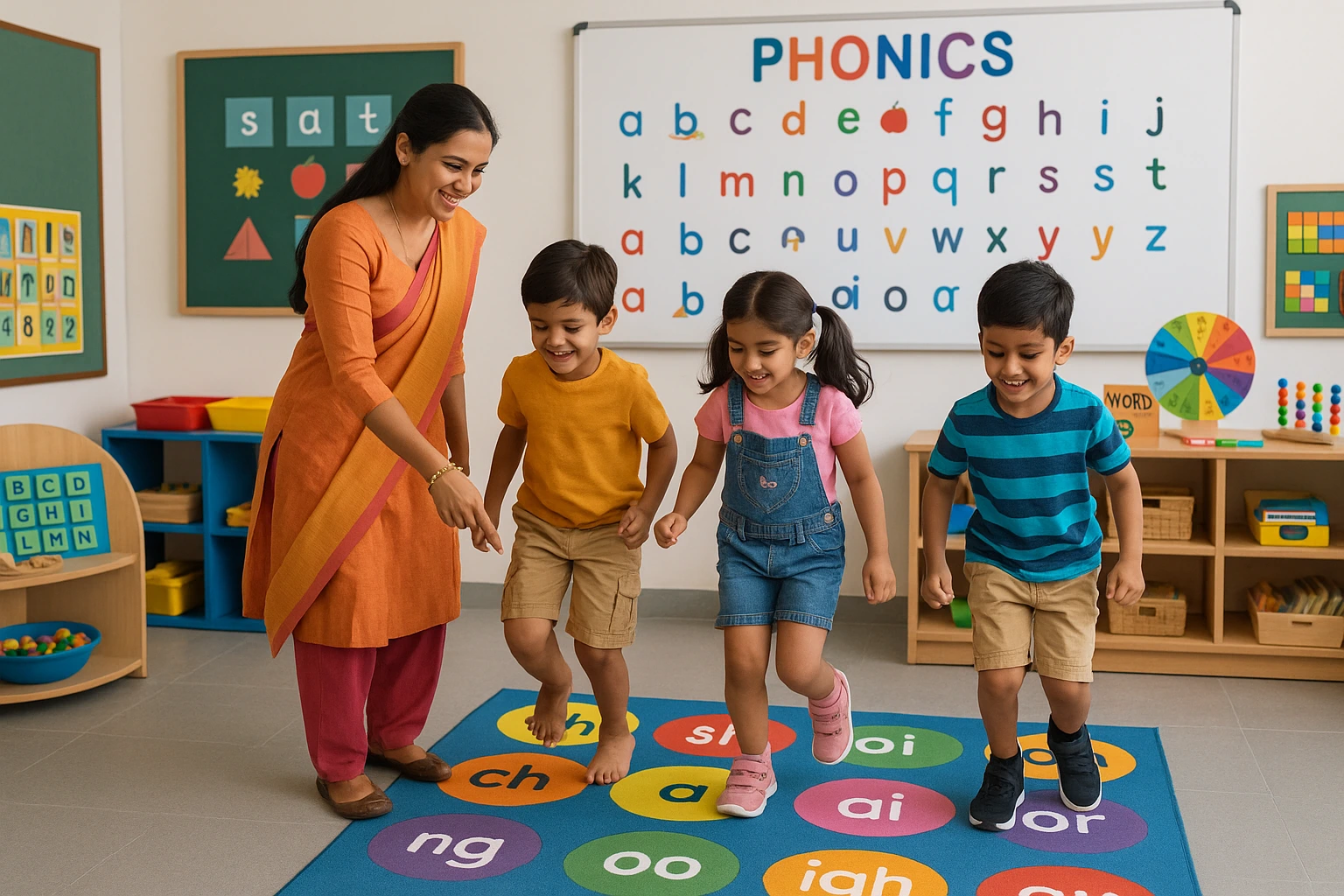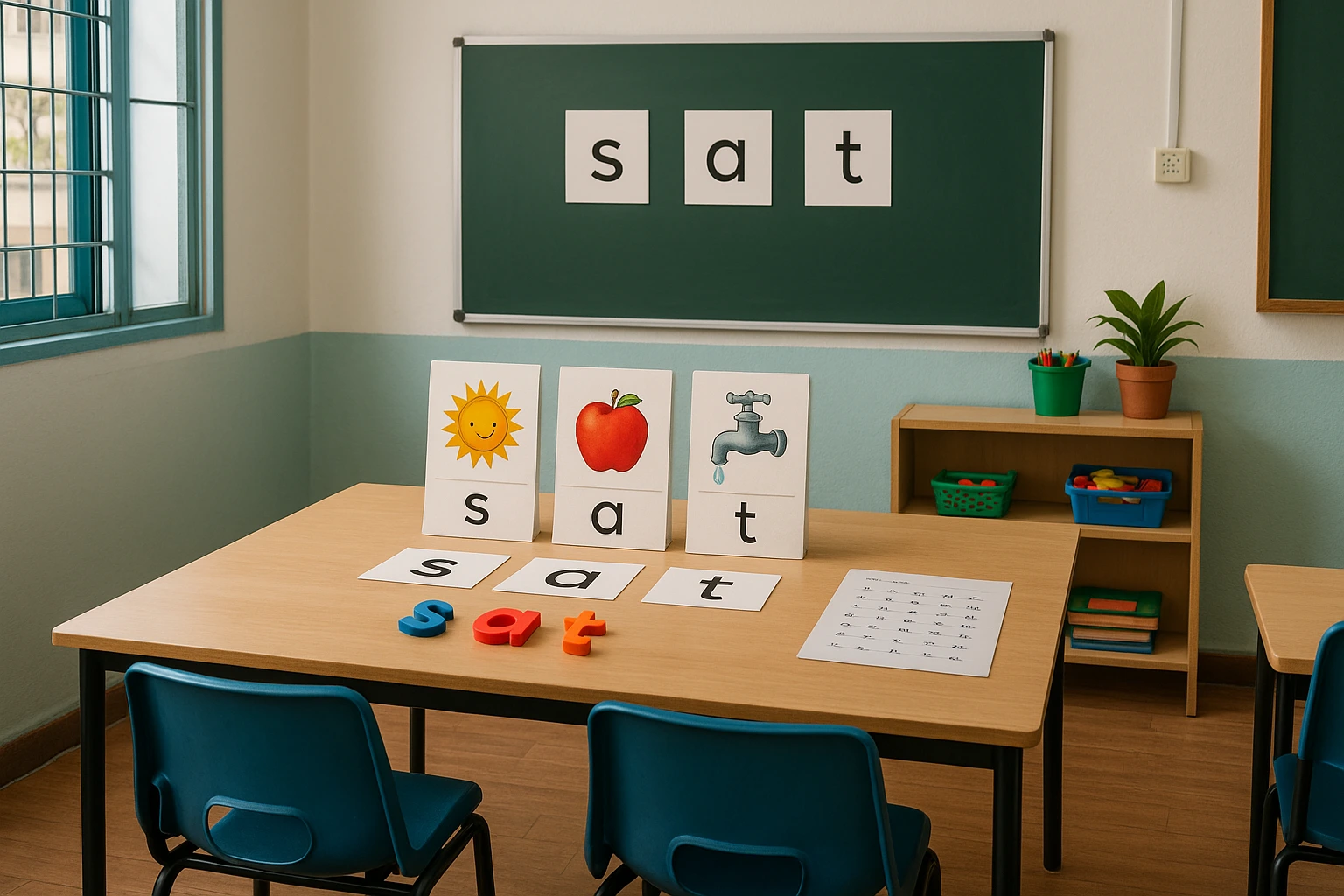How to Write Phonics Lesson Plans?
Source: landmarkschool
How to Write Phonics Lesson Plans?
Phonics Lesson Plans, an integral part of Phonics pedagogy, is a stepwise guide that helps teachers systematize what and how they will teach.
Explicit Phonics Lesson Plans help ensure that children learn systematically. Learning to Write Phonics Lesson Plans can be of great help to beginners as well as experienced educators looking to redefine their teaching approach.
Table of Content
Steps to Making a Lesson
Designing exceptional Phonics Lesson Plans involves organizing classroom activities in a manner that creatively supports learning. With a clear format, both the teacher and learners stay focused on the objectives of the session.
Let us have a look at the Steps to Making a Lesson plan centered on the learning goal:
To amplify children’s proficiency to blend and segment simple CVC Words (three-letter words with consonant, vowel, and consonant sounds in the respective order).
- Phonics Lesson Plan: Learning Goal– Blending and Segmenting CVC Words
- Phase Level: Kindergarten / Early Primary
- Span: 60 minutes
- Focus: Blending and segmenting with sound acknowledgement
- Preliminary Exercise: Phonics Flashcards (10 minutes)
- Objective: Establish the tone for the lesson by reminiscing on prior knowledge
- Use phonics flashcards with distinct letters and their respective CVC words (e.g., cat, sun, bin)
- Begin with one card at a time and let students express the sound aloud
- Practice letter-sound connection
- Repetition in groups to reinforce correct enunciation
This section of the Phonics Lesson Plans builds a healthy foundation for sound recognition before blending activities begin.
Main Activity: Blending and Segmenting (20 minutes)
Goal: Help students blend individual sounds to form words and segment words into sounds
Begin with teacher modeling:
- Say individual sound slowly: /b/ /i/ /n/
- Blend the sounds to say the word “bin”
- Use visual aids like magnetic letters or a whiteboard to demonstrate the sound-to-word connection
- Allow students to practice blending on their own or in pairs using teacher-prepared cards
- Introduce segmenting:
- Say a word like “fan” and ask students to split it into /f/ /a/ /n/
- Provide immediate feedback and repeat difficult sounds
This segment of the Phonics Lesson Plans encourages active student participation and helps solidify the skill of connecting sounds to form complete words.

Interactive Phonics Games (15 minutes)
Purpose:
Strengthen concepts in a delightful, engaging way
- Play games like “Phonics Hop,” where students hop on letters to build a word
- Use digital phonics games if available, or organize a “Sound Bingo” activity
- Include both blending and segmenting challenges
- Promote group work to build peer learning
Including games in Phonics Lesson Plans helps preserve interest and vibrancy while strengthening learning purposes.
Self-reliant Practice:
Worksheets (15 minutes)
Goal:
Boost learning through individual application
- Hand out worksheets that include activities such as:
- Correspond the picture with the appropriate CVC word
- Complete the word by filling in the missing letter
- Mark the correct word from a set of similar-sounding words
- Monitor students as they learn, providing help when required
- Examine answers jointly as a group
This independent task in the Phonics Lesson Plans gives teachers an opportunity to evaluate individual understanding and provide targeted support.
Developing exceptional Phonics Lesson Plans requires organizing, structure, and creativity. By incorporating introductions, focused teaching, interactive activities, and self-dependent work, phonics instruction becomes both applicable and delightful. Using these detailed Steps to Making a Lesson plan helps ensure students stay involved and make measurable advancement in their reading skills.
To download the brochure of Phonics Course, Click Here!
Call or Whatsapp on +918104606573 / +919869866277, for details of Phonics Course!

Phonics Sample Lesson Plans
Practical Phonics Lesson Plans play an integral role in building a robust basis in reading. These plans guide teachers in delivering phonics instruction in an explicit, stepwise form. By enrolling in Vidhyanidhi Education Society’s (Govt. Regd.) Phonics Teacher Training Course, you can master in preparing such effective lesson plans.
Below are detailed Phonics Sample Lesson Plans developed for early learners:
Phonics Lesson Plan 1: Letter-Sound Recognition (s, a, t):
Objective
Children will acknowledge and enunciate the sounds of the letters s, a, and t.
Required Materials
- Flashcards with letters s, a, t
- Picture cards (sun, apple, tap)
- Letter tiles or magnetic letters
Steps
- Begin with a quick review of earlier taught sounds.
- Familiarize the sound /s/ using the letter- s. Display pictures (e.g., sun) and recite the sound.
- Repeat the exact approach for /a/ and /t/.
- Let children match the letter cards with picture cards.
- Practice blending: Show “s-a-t” and blend the sounds to form “sat.”
- Strengthen learning with a related worksheet.
This is a basic illustration of how Phonics Lesson Plans can concentrate on a small set of letters to build acquaintance and confidence. Straightforward Phonics Lesson Plans with repetition help children retain what they learn.
Phonics Lesson Plan 2: Blending CVC Words
Objective
Children will blend three sounds: a Consonant, a Vowel, and a Consonant sound to read CVC words.
Required Materials
- Word cards: cat, dog, sun, pen, pig
- Whiteboard and markers
- Blending strips
Steps:
- Start with verbal blending exercises (e.g., “c-a-t” → “cat”).
- Show a word card, ask the child to recognize each sound, and then blend them.
- Use blending strips where each letter is disclosed one at a time.
- Play a word sorting game: real vs. nonsense words.
- Close with a read-aloud and identify CVC words.
By using Phonics Lesson Plans like this one, educators support reading fluency through repeated blending practice. Such Phonics Lesson Plans reinforce word recognition and prepare children for reading sentences.
Phonics Lesson Plan 3: Segmenting for Spelling
Objective
Children will segment sounds in CVC words to enhance spelling.
Required Materials
- Letter tiles
- Spelling notebooks
- Picture prompts
Steps
- Begin by saying a word (e.g., “dog”) and ask the child to identify each sound.
- Use letter tiles to build the word after segmenting sounds.
- Repeat with multiple examples.
- Conduct a quick dictation session with 3–5 CVC words.
- Wrap up with a reflection or word hunt activity.
Segmenting-focused Phonics Lesson Plans train learners to listen to individual sounds and connect them to letters while writing. This builds both spelling and reading accuracy.
These elaborate Phonics Sample Lesson Plans provide structure and clarity for both teacher and learner. Using clear goals and interactive steps to Write Phonics Lesson Plans, educators can make phonics engaging and practical for early readers. Keeping consistency and repetition within Phonics Lesson Plans guarantees long-term understanding and success in learning.
Master phonics planning—join Vidhyanidhi’s Phonics Course and teach with ease!
To download the brochure of Phonics Course, Click Here!
Call or Whatsapp on +918104606573 / +919869866277, for details of Phonics Course!
FAQs
How do I Start a Phonics Class?
Begin with basic letter sounds, use visuals and repetition, engage learners with activities, and follow structured Phonics Lesson Plans for effective progress.
What is the First Step of Lesson Plan?
The first step is setting a clear learning goal that fits what the students should acquire by the end of the phonics session.





